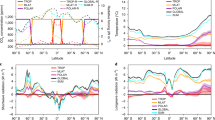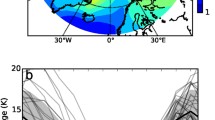Abstract
The Northern Hemisphere polar amplification of climate change is documented in models taking part in the Coupled Model Intercomparison Project and in the new version of the Community Climate System Model. In particular, the magnitude, spatial distribution, and seasonality of the surface warming in the Arctic is examined and compared among the models. The range of simulated polar warming in the Arctic is from 1.5 to 4.5 times the global mean warming. While ice-albedo feedback is likely to account for much of the polar amplification, the strength of the feedback depends on numerous physical processes and parametrizations which differ considerably among the models. Nonetheless, the mean sea-ice state in the control (or present) climate is found to influence both the magnitude and spatial distribution of the high-latitude warming in the models. In particular, the latitude of the maximum warming is correlated inversely and significantly with sea-ice extent in the control climate. Additionally, models with relatively thin Arctic ice cover in the control climate tend to have higher polar amplification. An intercomparison of model results also shows that increases in poleward ocean heat transport at high latitudes and increases in polar cloud cover are significantly correlated to amplified Arctic warming. This suggests that these changes in the climate state may modify polar amplification. No significant correlation is found between polar amplification and the control climate continental ice and snow cover.








Similar content being viewed by others
References
Barthelet P, Bony S, Braconnot P, Braun A, Cariolle D, Cohen-Solal E, Dufresne J-L, Delecluse P, Deque M, Fairhead L, Filiberti M-A, Forichon M, Grandpeix J-Y, Guilyardi E, Houssais M-N, Imbard M, LeTreut H, Levy C, Li ZX, Madec G, Marquet P, Marti O, Planton S, Terray L, Thual O, Valcke S (1998a) Simulations couplees globales de changements climatiques associes a une augmentation de la teneur atmospherique en CO2. CR Acad Sci Paris, Sciences de la terre et des planetes (in French with English summary) 326: 677–684
Barthelet P, Terray L, Valcke S (1998b) Transient CO2 experiment using the ARPEGE/OPAICE nonflux corrected coupled model. Geophys Res Lett 25: 2277–2280
Boville BA, Gent PR (1998) The NCAR Climate System Model, Version One. J Clim 11: 1115–1130
Colman RA (2001) On the vertical extent of atmospheric feedbacks. Clim Dyn 17: 391–405
Cubasch U, Voss R, Hegerl GC, Waszkewitz J, Crowley TJ (1997) Simulation of the influence of solar radiation variations on the global climate with an ocean–atmosphere general circulation model. Clim Dyn 13: 757–767
Curry JA, Rossow WB, Randall D, Schramm JL (1996) Overview of Arctic cloud and radiation characteristics. J Clim 9: 1731–1764
Delworth TL, Knutson TR (2000) Simulation of early 20th century global warming. Science 287(5461): 2246–2250
Emori S, Nozawa T, Abe-Ouchi A, Numaguti A, Kimoto M, Nakajima T (1999) Coupled ocean–atmosphere model experiments of future climate change with an explicit representation of sulfate aerosol scattering. J Metorol Soc Japan 77: 1299–1307
Flato GM, Boer GJ, Lee WG, McFarlane NA, Ramsden D, Reader MC, Weaver AJ (2000) The Canadian Centre for Climate Modelling and Analysis global coupled model and its climate. Clim Dyn 16: 451–467
Flato GM, Hibler WD (1992) Modeling pack ice as a cavitating fluid. J Phys Oceanogr 22: 626–651
Gordon HB, O'Farrell SP (1997) Transient climate change in the CSIRO coupled model with dynamic sea ice. Mon Weather Rev 125: 875–907
Gordon C, Cooper C, Senior CA, Banks HT, Gregory JM, Johns TC, Mitchell JFB, Wood RA (2000) The simulation of SST, sea ice extents and ocean heat transports in a version of the Hadley Centre coupled model without flux adjustments. Clim Dyn 16: 147–168
Hunke EC, Dukowicz JK (1997) An elastic-viscous-plastic model for sea ice dynamics. J Phys Oceanogr 27: 1849–1867
Ingram WJ, Wilson CA, Mitchell JFB (1989) Modeling climate change: an assessment of sea ice and the surface albedo feedbacks. J Geophys Res 94: 8609–8622
IPCC, Climate Change (1995) The science of climate change. Cambridge University Press, Cambridge, UK, pp 572
IPCC, Climate Change (2001) The scientific basis. Contribution of Working Group 1 to the Third Assessment Report of the Intergovernmental Panel on Climate Change. In: Houghton JT, Ding Y, Griggs DJ, Noguer M, van der Linden PJ, Dai X, Maskell K, Johnson CA (eds) Cambridge University Press, Cambridge, UK pp 881
Johns TC (1996) A description of the Second Hadley Centre Coupled Model (HadCM2). Climate Research Technical Note 71, Hadley Centre, United Kingdom Meteorological Office, Bracknell Berkshire RG12 2SY, United Kingdom, pp 19
Johns TC, Carnell RE, Crossley JF, Gregory JM, Mitchell JFB, Senior CA, Tett SFB, Wood RA (1997) The second Hadley Centre coupled ocean–atmosphere GCM: model description, spinup and validation. Clim Dyn 13: 103–134
Manabe S, Stouffer RJ (1980) Sensitivity of a global climate model to an increase of CO2 concentration in the atmosphere. J Geophys Res 85: 5529–5554
Manabe S, Stouffer RJ, Spelman MJ, Bryan K (1991) Transient responses of a coupled ocean–atmosphere model to gradual changes of atmospheric CO2. Part I: annual mean response. J Clim 4: 785–818
Meehl GA, Collins WD, Boville BA, Kiehl JT, Wigley TML, Arblaster JM (2000a) Response of the NCAR climate system model to increase CO2 and the role of physical processes. J Clim 13: 1879–1898
Meehl GA, Boer GJ, Covey C, Latif M, Stouffer RJ (2000b) Coupled Model Intercomparison Project. Bull Am Meterol Soc 81: 313–318
O'Farrell (1998) Investigation of the dynamic sea ice component of a coupled atmosphere–sea ice general circulation model. J Geophys Res 103: 15,751–15,782
Power SB, Tseitkin F, Colman RA, Sulaiman A (1998) A coupled general circulation model for seasonal prediction and climate change research. BMRC Research Report 66, Bureau of Meteorology, Australia
Rind D, Healy R, Parkinson C, Martinson D (1995) The role of sea ice in 2×CO2 climate model sensitivity. Part I: the total influence of sea ice thickness and extent. J Clim 8: 449–463
Rind D, Healy R, Parkinson C, Martinson D (1997) The role of sea ice in 2×CO2 climate model sensitivity. Part II: hemispheric dependencies. Geophys Res Lett 21: 1491–1494
Russell GL, Miller JR, Rind D (1995) A coupled atmosphere–ocean model for transient climate change studies. Atmos-Ocean 33: 683–730
Shine KP, Henderson-Sellers A, Barry RG (1984) Albedo-climate feedback: the importance of cloud and cryosphere variability. In: Berger AL, Nicolis C (eds) New perspectives in climate modeling. Elsevier, Amsterdam, pp 135–155
Tokioka T, Noda A, Kitoh A, Nikaidou Y, Nakagawa S, Motoi T, Yukimoto S, Takata K (1996) A transient CO2 experiment with the MRI CGCM: Annual mean response. CGER's Supercomputer Monograph Report Vol 2, CGER-IO22-96, ISSN 1341-4356, Center for Global Environmental Research, National Institute for Environmental Studies, Environment Agency of Japan, Ibaraki, Japan, pp 86
Washington WM, Meehl GA (1996) High-latitude climate change in a global coupled ocean–atmosphere–sea ice model with increased atmospheric CO2. J Geophys Res 101: 12,795–12,801
Washington WM, Weatherly JW, Meehl GA, Semtner AJ, Bettge TW, Craig AP, Strand WG, Arblaster J, Wayland VB, James R, Zhang Y (2000) Parallel climate model (PCM) control and transient simulations. Clim Dyn 16: 755–774
Weatherly JW, Briegleb BP, Large WG, Maslanik JA (1998) Sea ice and polar climate in the NCAR CSM. J Clim 11: 1472–1486
Weatherly JW, Zhang Y (2001) The response of the polar regions to increased CO2 in a global climate model with elastic-viscous-plastic sea ice. J Clim 14: 268–283
Wetherald RT, Manabe S (1988) Cloud feedback processes in a general circulation model. J Atmos Sci 45: 1297–1415
Acknowledgements
We gratefully acknowledge the CMIP modeling groups for conducting the CMIP model simulations and making the model data available. The Program for Climate Model Diagnostics and Intercomparison (PCMDI) at the Lawrence Livermore National Laboratory is also acknowledged for archiving and providing the CMIP model data. We thank Dr. Peter Gent for comments on a draft manuscript and Dr. Greg Flato for useful discussions during the course of this work. We also thank two anonymous reviewers for helpful comments. This work was supported in part by a grant from the National Science Foundation, Office of Polar Programs through the SHEBA phase 3 program to MM Holland. CM Bitz was supported by NSF grant OPP0084287.
Author information
Authors and Affiliations
Corresponding author
Rights and permissions
About this article
Cite this article
Holland, M.M., Bitz, C.M. Polar amplification of climate change in coupled models. Climate Dynamics 21, 221–232 (2003). https://doi.org/10.1007/s00382-003-0332-6
Received:
Accepted:
Published:
Issue Date:
DOI: https://doi.org/10.1007/s00382-003-0332-6




